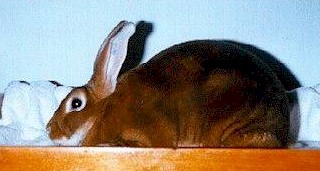

A Rex rabbit differentiates from other rabbits mainly due to its unusual velvet like fur. This fur is thick and short and stands straight up creating a very plush effect. Guard hairs are almost as short as the undercoat, giving the fur the same rich, even appearance as an expensive pile carpet.
The Rex rabbit began as a mutation and was first seen in a litter of wild gray rabbits in France in 1919. The youngster began with a short furred wooly coat, but a few months later, the wooly coat fell off leaving a magnificent shortened coat of chestnut brown. Meanwhile, a second of the opposite sex was born in another litter, thus producing the Adam and Eve of the Rex rabbit.
Noting the unique characteristics of the fur structure on these new animals, the French farmer who had bred the wild rabbits consulted a parish priest, Father Gillet, who also raised rabbits. It was Father Gillet who first named these rabbits "Castor Rex" - Castor meaning beaver in color and Rex meaning King.
In 1924, these unique rabbits made their world famous debut at the great Paris International Rabbit Show. John C. Fehr, one of America's pioneer rabbit raisers and judges, promptly purchased some of the unusually furred rabbits and introduced them into the United States. In 1924, Fehr and his partner, Alfred Zimmerman, were compelled to pay $350 for a pair of Castor Rex - a very expensive price for those days.
Four years later In 1928, again at the Paris International Exhibition, Rex made another grand debut. This time the varieties in exhibit were Chinchilla Rex, Ermine (White) Rex, Black Seal Rex, Black Otter Rex, Blue Mole Rex, Squirrel Rex, and Castor Rex. Other varieties were later developed in England, France and Germany during the early thirties. Fred Woodgate, an English rabbit judge and author, was one of many who held the opinion that the new rabbits were rather peculiar. He wrote: "Quite true, Rex were nothing to look at; in fact, they were ugly animals, In many cases devoid of ear covering and bare at the back of the neck. Long In body, long in leg, with a definitely arched back, and with a pair of ears, which were out of proportion, they resembled a kangaroo as much as anything
Many of the faults described by Fred Woodgate in the late twenties were apparent in the American stock of the thirties. One of John Fehr's own rabbits, Fehr's Queen, had a pair of ears that would put a Flemish Giant to shame, and a very definite dip behind the neck, as well as a long, arched body. Another Rex, called the Ermine King, was photographed in a pose that showed small curved front legs. The animal's hind legs V'd out much like a rabbit with sore hocks. Its ears were also massive.
Despite these obvious faults, however, the Rex created a sensation wherever it was shown, because of its unique fur structure. It was the fur that stirred the enthusiasm and imagination of its new owners, who often were the receivers of undue ridicule and laughter. Then too, as now, promoters and speculators victimized potential Rex raisers. Large shipments of these fine furred animals were imported to be sold at shows and ARBA Conventions. Unheard of prices were paid for these precious imports, sometimes amounting to $1,500 per pair. (Remember, this was in 1929.) Some of these promoters also went broke in their conquest of riches.
Early Rex were shown by breed designation as Flemish Rex, Beveren Rex, New Zealand Rex and so on. The early standards for each of the various breeds were identical to the normal-furred variety, with the exception that the fur was "to be very dense and soft, with no overcoat of guard hairs protruding". Unfortunately, the length of the fur varied from breed to breed, from 1/2" to 3/4" in length.
Any of the clubs sponsoring normal-furred rabbits also sponsored the Rex, which of course, created a lot of confusion. The Rex rabbits and their breeders went through some very trying times, until at last the "uniform Rex standard" was first introduced. This "standardized" the Rex in appearance as well as fur structure.
Ó Reprinted from the National Rex Rabbit Guide Book and Standard of Perfection